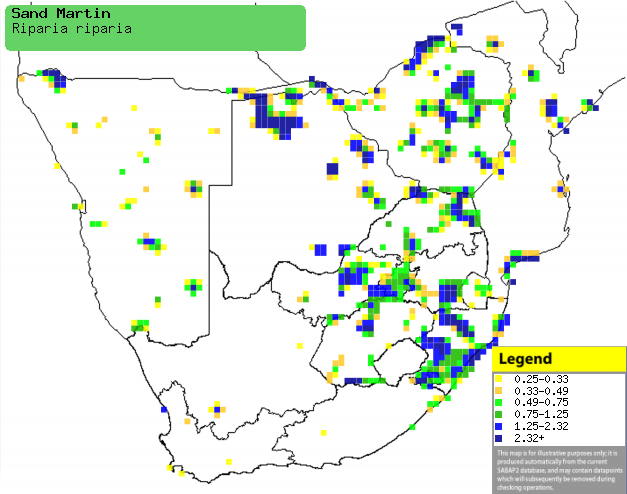|
Riparia riparia (Sand martin)
Europese oewerswael [Afrikaans]; Sisampamema (generic term
for swallows, martins, swifts and spinetails) [Kwangali]; Nyenganyenga (generic
name for swallow or martin) [Shona]; Oeverzwaluw [Dutch]; Hirondelle de rivage
[French]; Europäische uferschwalbe [German]; Andorinha-das-barreiras-europeia
[Portuguese]
Life
> Eukaryotes >
Opisthokonta
> Metazoa (animals) >
Bilateria >
Deuterostomia > Chordata >
Craniata > Vertebrata (vertebrates) > Gnathostomata (jawed
vertebrates) > Teleostomi (teleost fish) > Osteichthyes (bony fish) > Class:
Sarcopterygii (lobe-finned
fish) > Stegocephalia (terrestrial
vertebrates) > Tetrapoda
(four-legged vertebrates) > Reptiliomorpha > Amniota >
Reptilia (reptiles) >
Romeriida > Diapsida > Archosauromorpha > Archosauria >
Dinosauria
(dinosaurs) > Saurischia > Theropoda (bipedal predatory dinosaurs) >
Coelurosauria > Maniraptora > Aves
(birds) >
Order: Passeriformes > Family: Hirundinidae
Distribution and habitat
Its breeding grounds are in North America and Eurasia,
moving south in the non-breeding season to South America, the Far East and
sub-Saharan Africa. Here it is locally common from west to east Africa down to
southern Africa but absent from much of the lowland equatorial forests of the
DRC and the Congo. In southern Africa it is widely distributed but scarce, most
common in the Caprivi Strip, Namibia and northern Botswana, but also occurring
in Zimbabwe, Namibia and the eastern half of South Africa, rarely recorded in
the Western Cape. It can be found in a variety of habitats, but it is most
common in the marsh and grassland of the Okavango Delta, also occupying sewage
works, grassland and Mopane (Colosphermum mopane) woodland.
|
 |
|
Distribution of Sand martin in southern Africa,
based on statistical smoothing of the records from first SA Bird Atlas
Project (©
Animal Demography unit, University of
Cape Town; smoothing by Birgit Erni and Francesca Little). Colours range
from dark blue (most common) through to yellow (least common).
See here for the latest distribution
from the SABAP2. |
Movements and migrations
Intercontinental migrant, arriving in southern
Africa mainly in October extending into December, departing around
March-April.
Food
It eats flying insects, foraging close to vegetation or the
water surface, sometimes in flocks with other swallows.
Threats
Not threatened.
References
-
Hockey PAR, Dean WRJ and Ryan PG 2005. Roberts
- Birds of southern Africa, VIIth ed. The Trustees of the John Voelcker
Bird Book Fund, Cape Town.
-
Harrison, J.A., Allan, D.G., Underhill, L.G., Herremans, M.,
Tree. A.J., Parker, V. & Brown, C.J. (eds). 1997. The atlas of southern
African birds. Vol. 2: Passerines. BirdLife South Africa, Johannesburg.
|
